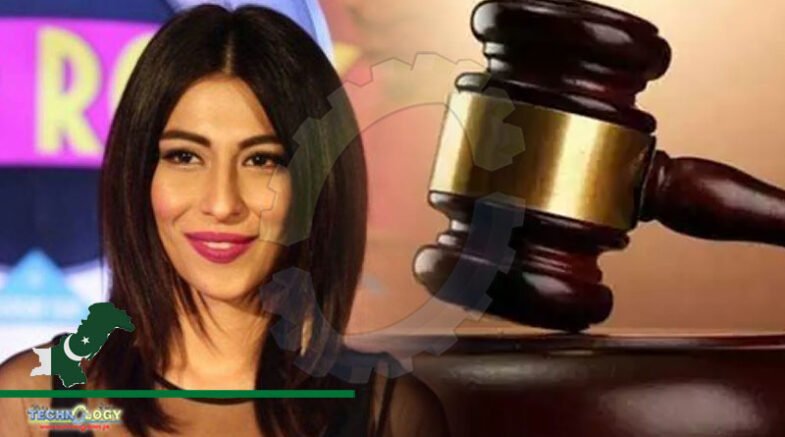The top court held that the evidence of a witness who was not physically present in court could be recorded in a civil case by using the modern technology of video conferencing within the existing legal framework.

Meesha Shafi’s plea to record statement via video link technology gets approved by Supreme Court. The top court held that the evidence of a witness who was not physically present in court could be recorded in a civil case by using the modern technology of video conferencing within the existing legal framework.
A 12-page judgment authored by Justice Syed Mansoor Ali Shah, while setting aside the Lahore High Court’s (LHC) decision, approved singer Meesha Shafi’s plea and declared that she did not need to come to Pakistan to record a statement. She can record a statement via video link.
Justice Mansoor Ali Shah said that Meesha Shafi had been living in Canada since 2016 and was a mother of two children, she did not need to come to Pakistan just to record a statement. It is feasible for singer to record statement via video link technology.
The court order stated that the singer did not even need to go to the Pakistani embassy in Canada for cross-examination.
According to the text of the order, Shafi was being interrogated for the last eight months and regretted that unfortunately, delaying tactics in cross-examination were used to pressurise the affected party to change the statement.
Virtual attendance
The ruling held that that the virtual attendance of a witness in court, thus, appears to be the species of the genus of “attendance” required under Rule 4 and fulfils the legislative purpose and policy in requiring the attendance of a witness in court for recording his evidence.
“Therefore, we can legitimately conclude that the word ‘attendance’ used in Rule 4 can be extended to ‘virtual attendance’ and the word ‘attendance’ mentioned in this rule does not mean only ‘physical attendance’ but includes ‘virtual attendance’ made possible by the modern technology of video conferencing,” it added.
A division bench of the apex court led by Justice Qazi Faez Isa had deliberated over the question whether the evidence of a witness who is not physically present in court can be recorded in a civil case by using the modern technology of video conferencing within the existing legal framework.
Rule 4 of Order 18 of CPC says that the evidence of the witnesses in attendance shall be taken orally in open court in the presence and under the personal direction and superintendence of the judge.
The judgment noted that the “virtual attendance” of a witness in court through the medium of video conferencing enables the judge and other persons present in court to see the witness and hear what he says, and vice versa.
Such attendance is thus, in effect, in open court, and his evidence is also recorded under the personal superintendence of the judge. The judge under whose superintendence the evidence through video conferencing recorded can satisfy himself about the free will of the witness present on screen as he does about the witness present physically in court by questioning him in this regard and ensuring that he is not under the immediate influence of any other person.
“Needless to say that a court can ensure the independence of a witness only from the immediate influence, not from any covert influence, of any other person in both situations whether he is physically present or virtually present in court. In the latter situation, the court can ensure that there is no other person in the room where the witness is sitting, while his evidence is being recorded, by asking him to provide a full view of that room on the screen,” the judgement said.
It further explained that the identity of the witness, if disputed, can also be verified by the judge through appropriate means. The witness can be confronted on screen with documents produced or sought to be produced in court by any of the parties or, if needed, the scanned copies of such documents can be sent to him through modern means of communication. In all such necessary matters as to the recording of evidence, the physical attendance and the virtual attendance of a witness in court do not differ.
The judgment noted that admittedly, the CPC is silent on the matter of evidence recording through video link technology: there is no express provision either allowing or prohibiting such procedure of recording evidence.
And regarding the procedural law, the judgement observed that it was a well-settled principle that the ‘courts are not to act upon the principle that every procedure is to be taken to be prohibited unless it is expressly provided for by the Code [of Civil Procedure], but on the converse principle that every procedure is to be understood as permissible till it is shown to be prohibited by law.
“As a matter of general principle, prohibition cannot be presumed. The provisions of Section 151, which empowers the civil courts to make such orders as may be necessary for the ends of justice or to prevent abuse of the process of the court, are intended to preclude the possibility of the civil courts being stuck in a situation for any omission in the CPC. The inherent powers of the civil courts saved by Section 151 are thus supplementary to their powers stated expressly in the CPC and are to be exercised where the situation is not covered by any provision of the CPC.”
“It hardly needs lengthy arguments to establish that when in the circumstances of a case, requiring physical attendance of a witness in court will incur an unnecessary amount of delay, expense or inconvenience, the order of the court allowing virtual attendance of a witness and recording statement via video link technology is for the ends of justice, and the rejection of an unjustifiable insistence of the opposing party on securing physical attendance of such witness in court is to prevent abuse of the process of the court.”
“An order allowing virtual attendance of the witness in such circumstances thus squarely falls within the scope of Section 151 of the CPC.”
The judgment notes that Article 164 of the QSO is actually our gateway to allowing modern science and technology to come into our courtrooms. If justice is to be done, then the law must not become stagnant or archaic while society moves forward. It must be accessible, and intelligible and must change with time, responding to the realities of modern life, it added.
“In the present age of information technology, no one can dispute the advantages of the use of this technology in courts for improving the efficiency of the judicial process and reducing the delay in the dispensation of justice. As the ultimate objective of the law is to serve society, the courts need to embrace and use technological developments with a pragmatic and dynamic approach in case management and court proceedings, for dispensing justice more efficiently and expeditiously.”
“The above interpretation of the various provisions of law allowing modern technology of video conferencing to be read into the exiting enactments enhances access to justice, promotes fair trial and introduces inexpensive and expeditious justice thereby advancing the fundamental rights under articles 9 and 10A and the principle of policy under article 37(d) of the Constitution of the Islamic Republic of Pakistan, 1973.”
The judgment noted that there is a regrettable practice to use the tool of prolonged cross-examination for the purpose of leading the witness into some error by exhausting him through unnecessary and irrelevant questioning.
“This practice is designed not for the disclosure of truth but for the manipulation of error. In such a situation the presiding officer of the court, the judge, should not remain a silent spectator but should act as a vigilant supervisor, for the right of cross-examination is neither unlimited nor unbridled. When the judge observes that the right of cross-examination is being abused by asking questions which are irrelevant and intended to prolong the cross-examination with the object of manipulating error, or to scandalise, insult or annoy the witness, he should intervene and disallow such questions.”
The apex court noted that the trial court and the high court have legally erred in disallowing it. Their orders rejecting the prayer of the petitioner are not sustainable.
The present petition for leave to appeal is, therefore, converted into an appeal and the same is allowed. The impugned judgment is set aside, and the revision petition of the petitioner is allowed by setting aside the order of the trial court and accepting the application of the petitioner for recording her statement via video link technology, it added.
Originally published at Tribune
